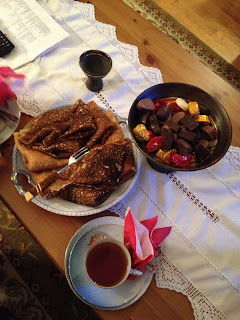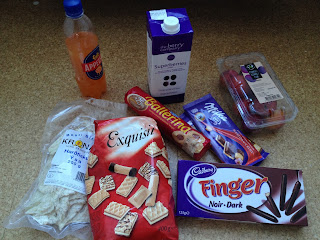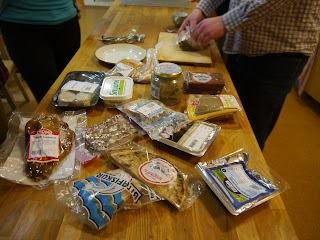When I started my journey with CELL
I would have by no means considered myself a “food freak”. My diet consisted
mainly of pasta smothered in canned tomato sauce, cheerios, and of course the
occasional dining hall dessert. Now of course I am intentionally leaving out
the vegetable stir-fries, salads, and homemade wheat bread. The point I am trying to make here is not that I considered
myself an unhealthy eater, but that despite my knowledge of healthy food
options I would still knowingly put bad things into my body. Thanks to the CELL program, however, those
days are now in the past.
We all knew before coming here that
certain foods are bad for you. For example, not even the most intelligent
college student could make a valid argument proving that a slice of cheese
pizza dripping in grease has any form of nutritional value. Yet we all still eat it. To make matters even
more complex, nutrition is really just the tip of the iceberg. Our food
choices, both personally and as a society, have ecological and social impacts
as well. These impacts can reverberate far outside the realm of our school
dining halls. In my natural resources classes we are taught about the
devastation of ecosystems in the Midwest from corn monocultures. We read about
government subsidies that crush small farms and limit access to fresh organic
food to low income families. Our professors preach about how the energy used to
transport our food is greater than the energy our bodies reap from eating it. Yet
most of us don’t think twice about what goes in our carriages at the super
market. So why isn’t the basic knowledge we have about heating healthy and our
food system enough? Why do nutrition majors still eat greasy cheese pizza?
The beauty of having the
opportunity to live an essentially isolated Eco-village for three months
(especially with a program like CELL) is that there are few if any
opportunities to continue a typical college diet. Our meals consist of mainly fish, vegetables,
and grains (this is a bit glorified, I’ll admit). One key player that gets left
out is processed food. Because we don’t have access to as much processed food
or sugar in general, all of our lessons about food (related to both health and
sustainability) suddenly seem to send off a different array of light bulbs in
my head. Now that I know of a life
without these types of food, all
of our lessons are inspiring me to actually apply this knowledge (both new and
old) to my lifestyle back home. I finally feel like I can commit to food
goals that are more consistent with my environmental values and what do you
know, apparently I could even become healthier too! In a way this program is
like food rehab. I consider myself extremely lucky to have hands-on experience
with eating a healthier and sustainable diet and I feel that these types of
experiences provide viable solutions to some of the questions I posed above;
they provide the push that college students need. Sadly though, not everyone
has the opportunity to have an experience like CELL. This will make coming home
very difficult. While I can’t individually send students at UNH on programs
like CELL, (as much as I’d like to) what I can do is start strongly encouraging
my fellow students to take value in organizations on campus like Slow Food or
Get Real, who are committed to the concept of making positive food choices.
Also, within the realm of my close friends I can start setting better examples.
It will not be easy, but the perspective I have gained here about food is
undoubtedly worth spreading.
With Easter fast approaching there
has been a lot of talk in our group about missing Easter candy (I’ll be honest,
most of it from me). The Emily that celebrated Easter prior to doing CELL might
not have been able to imagine an Easter without treats. However, now having
committed to making better food choices, I thought it would be appropriate to
say a final goodbye to some of the processed Easter treats that I’ve come to
love over the past 20 years. Would it be realistic for me to say that I’ll never
eat a piece of Easter candy again? Probably not, but I certainly have developed
my self-control.
Peeps: Ugh, don’t look at me with those cute
little eyes. You’ll always have each other; I mean c’mon you’re literally
melted together. Oh I will miss your sugary coating and soft marshmallow
innards. I remember so clearly the days of biting your heads off and then
saving your small misshapen bodies for my final bite. Remember when Justin and
I would put you in the microwave and watch you expand into a gooey sugary mass?
Your creators had it right when they decided to sugar coat you and with such
fun colors too! Your shimmery coating never failed to catch my eye even when
you were hidden amongst Reeses cups and the new deodorant stick in my basket. I wish we could just fly off together, but I
have dreams to chase and let’s be honest you’ll be stale by next week.

Chocolate rabbits: I’m
sure this comes as no surprise to a rabbit like yourself, but you were always
the crown jewel of my Easter basket each year. Your sideways glance would peer
my way as I delicately placed you aside.
You and I both knew that I would save you for last. In a lot of ways you
were a selfish candy, always so hollow. What about my feelings? I always hoped you would develop your inner rabbit,
but year after year I would take that first bite and be disappointed. I can’t
be selfish though, it really wasn’t your fault. Your simplicity made you all
the more delicious, all chocolate and nothing else. What more could a girl ask
for, really? I can hardly bare to watch you just hop away like this. Just go
already!

Jelly beans: I
never considered Easter to be a particularly exciting holiday, until I was
introduced to all of you. You guys really know how to start a party. Your
pizazz made even the most uneventful Easters as fun as a night out on the town.
You never failed to surprise me as I would mix and match with your unique
flavors. My taste even developed enough to love all you licorice flavored ones!
Furthermore, I attribute my ability to catch food in my mouth to you. I’ll
never forget those days of tossing you into the air one by one and like rain
from the gods you would fall on my tongue. Thank you for always inviting me
into your diverse community. You will be missed!
(Note: Contrary to popular belief,
I am not a crazy person)
By: Emily Spognardi





















